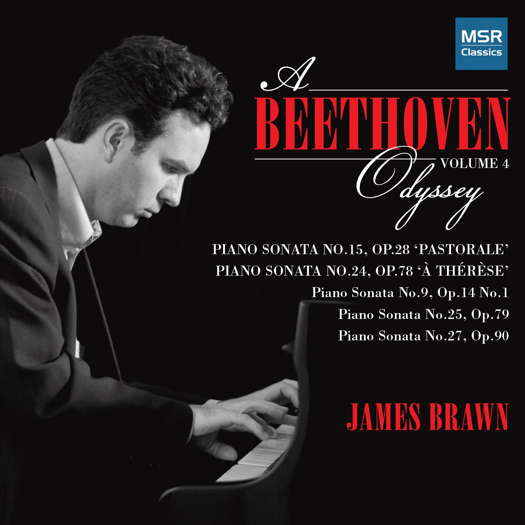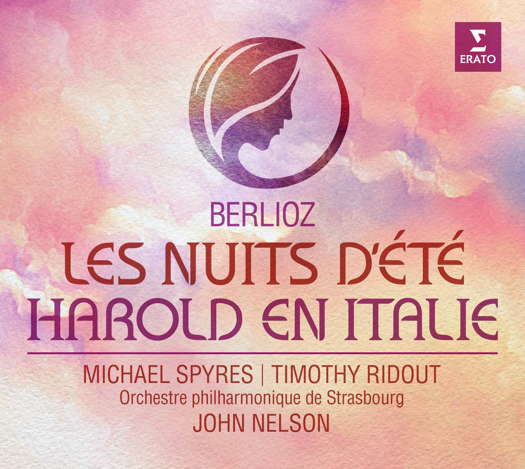- Ervín Šulhov
- André Caporale
- Verdi: Don Carlo
- gypsies
- Chris Shultis
- Slatina
- Colin Wilson
- Cecilia McDowall: Century Dances
 DISCUSSION: John Dante Prevedini leads a discussion about Music and the Visual World, including contributions from Celia Craig, Halida Dinova and Yekaterina Lebedeva.
DISCUSSION: John Dante Prevedini leads a discussion about Music and the Visual World, including contributions from Celia Craig, Halida Dinova and Yekaterina Lebedeva.
 SPONSORED: CD Spotlight. Pure Magic - James Brawn's continued Beethoven Odyssey, awaited by Andrew Schartmann.
SPONSORED: CD Spotlight. Pure Magic - James Brawn's continued Beethoven Odyssey, awaited by Andrew Schartmann.
All sponsored features >>

Themes of Love and Loss
Music by Berlioz impresses GERALD FENECH
'John Nelson's supreme mastery of these scores draws peerless performances full of exciting moments from the Orchestre philharmonique de Strasbourg, while bringing to the fore all the innovative details of orchestration and harmony.'
Berlioz's second symphony, Harold in Italy, owes its creation to the Italian composer Niccolò Paganini. The two first met after a concert of Berlioz's works conducted by Narcisse Girard on 22 December 1833, three years after the premiere of Berlioz's Symphonie Fantastique. According to the 'Memoires' of the Frenchman, Paganini had just acquired a 'superb viola', a Stradivarius, but had no suitable music to fit the instrument's capabilities. Paganini was an admirer of Berlioz's music, so it came naturally to him to ask the latter to compose a piece for solo viola, through which the Italian could display his dazzling virtuosity. Indeed, this is what Paganini said to Berlioz: 'You are the only one I can trust for this task'.
Berlioz began by writing a viola solo, but one which involved the orchestra in such a way as not to reduce the effectiveness of the orchestral contribution. When Paganini saw the sketch of the opening 'allegro' with all the rests in the viola part, he refused to accept it. Paganini was a proud man, and when performing he always sought to be the centre of attraction. Following this episode, the Italian parted company, bitterly disappointed. The inspiration for the piece is Lord Byron's poem Child Harold's Pilgrimage, and this is what Berlioz wrote about how this literary masterpiece inspired him to put it to music. 'My intention was to write a series of orchestral scenes, in which the solo viola would be involved as a more or less active participant while retaining its own character. By placing it among the poetic memories formed from my wanderings in the 'Abruzzi', I wanted to make the viola a kind of melancholy dreamer in the manner of Byron's Child Harold.'
The composition is structured in four long movements. The first, titled Harold in the Mountains, carries the subtitle 'Scenes of Sadness, Happiness and Joy'. It is an introspective introduction to the protagonist, a subtle theme, first played by the solo viola, that echoes throughout the work.
The second movement, The March of the Pilgrims Singing their Evening Prayer, contrasts Harold's lush romantic perspective with the pilgrims' religious fervour.
Listen — Berlioz: Allegretto (Harold in Italy)
(5054197196850 track 8, 3:23-4:19) ℗ 2022 Ascanio’s Purse :
The Serenade of the third movement depicts a mountaineer of the rugged 'Abruzzo' region singing to his beloved sweetheart. The English horn serves as the voice of the singer, yet Harold is there too, in the form of the solo viola, observing the intimate scene.
For the final movement, Berlioz turns to a more animated episode, The Orgy of the Brigands, but even amid the tumultuous action, he recalls the earlier scenes with musical echoes of the previous movements.
Listen — Berlioz: Allegro frenetico (Harold in Italy)
(5054197196850 track 10, 3:01-3:57) ℗ 2022 Ascanio’s Purse :
Harold in Italy was premiered on 23 November 1834 to considerable success. Indeed, the March of the Pilgrims was encored and the Brigands' Orgy generated a certain excitement. Paganini did not hear the work he had commissioned until 16 December 1838. On hearing the piece he was completely overwhelmed, and after the performance he dragged Berlioz onto the stage, and there knelt and kissed his hand before a wildly cheering audience and applauding musicians. A few days later he sent Berlioz a letter of congratulations, enclosing a bank draft for twenty thousand francs.
After years of stalking his great romantic obsession, the actress Harriet Smithson, Berlioz finally married this darling of the stage on 3 October 1833. Completely different in character and temperament, many were expecting the marriage to fall apart almost overnight, but against all odds the union succeeded for several years. But by time, Harriet's star waned as Hector's rose, and she irrevocably slipped into the clutches of depression and alcoholism. Hector continued to support her, but by the early 1840s the marriage was effectively over, and in 1854, with Hector still caring for her, she died.
Given its themes of love and loss, many have speculated that Berlioz vented his sorrow at his marriage breakup in the song cycle Les nuits d'été (Summer Nights). Completed by the summer of 1841, the cycle is based on poems by the poet and writer Théophile Gautier, an acquaintance who lived near Berlioz in Paris. Berlioz originally composed Les nuits d'été for mezzo or tenor voice and piano, but later orchestrated it.
The opening 'Villanelle' invites the beloved to wander through the forest in springtime and features a simple, charming melody above a chirping accompaniment. Still, shadows pass over the music, belying its innocent surface.
In 'Le spectre de la rose', the ghost of a rose remembers the night it spent pinned to a beautiful woman's dress at a ball. The rose does not regret its death, but instead proclaims that 'all kings will envy it'. This song contains some of Berlioz's most evocative and expressive effects.
In Sur les lagunes, a sailor grieves for his dead beloved. Subtitled 'lament', this mournful song fades away poetically on an unresolved half-cadence.
In 'Absence', a vast distance separates the singer from the beloved. In context, the distance could metaphorically refer to that between this life and the next.
'Au cimetière' is the most chilling of the six songs, and the music is dark and eerie. It depicts a gothic scene in which the ghost of the beloved calls to the singer from beyond the grave. In this song the singer at last breaks free from grief, resolving never to return to the cemetery.
Listen — Berlioz: Au cimetière (Les nuits d'été)
(5054197196850 track 5, 3:29-4:28) ℗ 2022 Ascanio’s Purse :
In the final song, 'L'île inconnue', the singer steers a fanciful ship over the open ocean, asking a new beloved where she would like to go. She answers: 'Take me to the faithful shore where one loves forever'. The last words of the cycle, 'That shore is hardly known, my dear, in the land of love', leaves the listener to decide what answer he might have given.
Listen — Berlioz: L'île inconnue (Les nuits d'été)
(5054197196850 track 6, 2:52-3:35) ℗ 2022 Ascanio’s Purse :
This is music at its imaginary best: colourful, descriptive, emotional, passionate and most of all consistently alive with an inner energy and feeling that draws the listener into a different world. John Nelson's supreme mastery of these scores draws peerless performances full of exciting moments from the Orchestre philharmonique de Strasbourg, while bringing to the fore all the innovative details of orchestration and harmony. A fine addition to the Berlioz discography in exemplary sound and presentation.
Copyright © 3 December 2022
Gerald Fenech,
Gzira, Malta

CD INFORMATION - BERLIOZ: LES NUITS D'ÉTÉ; HAROLD EN ITALIE


